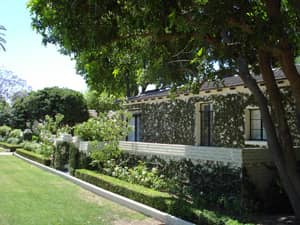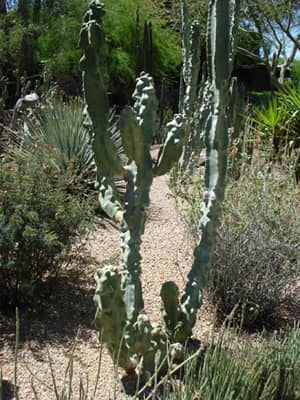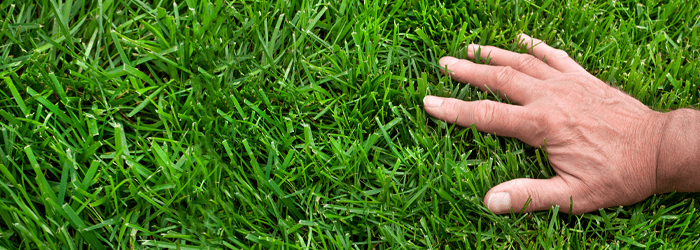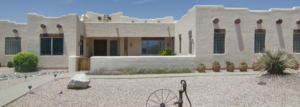It’s the time of year when Arizona residents start planning if they want to plant a new lawn in their yard. You need to decide what kind of grass to plant, how big that lawn will be, whether you’ll go for seeds or sod, and whether you’ll overseed in the fall as they do at many golf courses or whether you’ll go brown in winter.
If you’re new to Arizona, you’ve probably noticed that lots of people don’t even have lawns. That might seem strange if you’re from Minnesota or Illinois, but it can be liberating as well.
So, Why do you “want” to have grass in Arizona?
1 | Human beings like to play on grass and so do dogs.

In my case with six kids, 12 grandchildren and two (or more) dogs, grass seems like a necessity for recreation. You can play croquet or flag football or practice soccer or set up a badminton net. Over the years, we’ve managed to drop our area of grass to about a third by putting in a vegetable garden, a kennel and a sand volleyball court. But we still need that patch of grass.
2 | In some neighborhoods grass lawns seem almost mandatory.
Even though Arizona may seem grass-free, some areas like Arcadia in Phoenix are places where lawns are traditional and popular, partly because the water is cheap and plentiful and comes from nearby canals.
3 | Grass cools off the atmosphere.
You’ve probably noticed in summer, it’s a whole lot cooler to walk on grass than on an asphalt street or concrete sidewalk. Lots of scientific studies indicate that planting more grass of some kind plus trees would benefit our concrete- covered big cities.
4 | Grass helps control dust.
Lawns can trap dust and some pollen. Although some of us get allergy attacks from the type of grass itself, a lawn can trap pollen from other plants. Then when the grass is watered, those offensive pollen grains wash down into the soil.
5 | Grass provides an attractive ground cover to absorb rainwater (when we get it) and controls erosion.
Instead of rainwater rolling off into gutters and sewers; it is soaked up in your lawn.
Why might you “not want” to have grass in Arizona?
1 | Grass lawns are costly to maintain and one of the big expenses is water.

Lawns cannot live on rainwater alone in the desert; they’re always thirsty. You don’t want to haul a sprinkler around; it’s best to have an automatic sprinkler system. In drought periods, some places – like California – have even ordered homeowners to stop watering their lawns.
2 | Grass lawns can take lots of labor.
We’ve mentioned the watering already, then there’s the mowing and the fertilizing that needs doing at least once a month. If you do all these jobs yourself, there will be less expense, of course. But as Mary Irish, former director of public horticulture at the Desert Botanical Garden in Phoenix, once wrote: “You must water and care for a lawn always; it never grows up and leaves home.”
3 | You may need to use some chemicals to maintain your lawn.
Besides fertilizing, you may sometimes need to fight insects. Organic solutions are also possible but may require more patience.
4 | Lawns can attract critters.
You will also have to deter birds that eat the seeds you sow, rabbits that eat the grass and javelinas that dig up the grass to find the grubs in the soil.
5 | It may be “out of style” to have a lawn in your neighborhood.
In fact, in areas with a desert look to the landscaping, grass can be forbidden in front of the house and sometimes in the back. Check with your homeowner’s association about the rules. Nevertheless, grass can be less pricey than other ground covers and certainly costs less than decks and patios do. “Start by asking yourself what the purpose of the lawn will be,” says Jay Harper, Gardening and Landscaping Expert. “Plan one in a size that will fit your lifestyle.”
There’s another option. What about using artificial turf instead?
Artificial turf products have improved dramatically in recent years both in performance and appearance. The grass they use consists of polyethylene fibers threaded through a drainage layer that’s infilled with sand that can handle as much as 250 inches of water in an hour. It’s widely used in parks and on school playgrounds. However, some artificial turf can get very hot in Arizona’s summer heat. Do not run irrigation pipes under the turf. If you want to sprinkle it in summer, you need to install sprinklers around the turf instead. Turf without nylon in it does not get as hot.
###
PODCAST
It’s time to begin transitioning your lawn. Or not. Garden/Lawn Expert Jay Harper discusses cutting, watering and fertilizing tips to bring the summer bermuda lawns back from winter rye grass. Especially during the dry period before monsoon season. Plus what is the reason to ‘paint’ tree trunks.
Podcast Archive With Expanded Content and Resources
PHOTO CREDITS
- Rosie on the House
- Shutterstock
RELATED CONTENT
- DIY Q&A: Is it time to start watering my summer grass?
- DIY Q&A: What’s the best way to put down sod? Should I fertilize first?
- DIY Q&A: How to clean artificial grass and get rid of pet odors?
- BLOG: What can I do to update the look of my outdoor patio?
- Rosie-Certified Pool Contractors you can trust.










